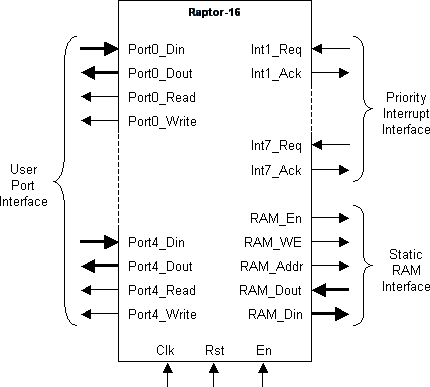The Raptor-16 is a 16-bit embedded microprocessor that boasts the following features:-
 |
- Full CISC Architecture
- Extremely Powerful Instruction Set
- 12 Base Instructions with 44,961 Combinations
- 4 Spare Instruction slots for Signed & Unsigned Divide & Multiply
- Variable Length Instructions (1, 2 or 3 words)
- Special Quick Instructions for Extremely Compact Code
- 12 Addressing Modes
- 16 Registers
- 4 Condition Codes
- 16 Branch Conditions
- Directly Accessible Stack Pointer and Program Counter
- 5 User Ports for External Communication
- 1 Control Register
- 7 Priority Interrupts with Masks
- Supports any Embedded RAM up to 65535 Words
- Low Power Implementation
- Very Small Gate Count ~ 500 Flops & 900 LUT's (Xilinx)
- Average Processing Power ~ 8 MIP's (50MHz cystal)
- Performance to Size ratio of 50 Instructions per LUT
- Written entirely in Synthesizable VHDL (RTL)
|
An
assembler for Raptor-16 also exists which features:-
- Source Optimization Warnings
- Compiled Source Listings
- Assembles source code transparently and then behaves just like a static RAM for simulation
- Automatic generation of initialized Xilinx Block RAM VHDL for use with Spartan 2/2E & WebPack implementation
- 256, 512, 1024, 2048 & 4096 16-bit RAM's supported
- Automatic generation of initialized Xilinx Block RAM VHDL for use with Spartan 3 & WebPack implementation
- 1024, 2048 4096, 8192 & 16384 16-bit RAM's supported
- Automatic generation of Xilinx RAM files (XCO & COE) for use with CoreGen* RAM implementation
- 256, 512, 1024, 2048, 4096, 8192, 16384, 32768 & 65536 16-bit RAM's supported
- Written entirely in Behavioural VHDL
Documentation:-
Validation Code:-
Example Designs:-
Other Source Code:-
* Please note CoreGen is not available in WebPack so I have no means of testing this feature.
The design source, testbench, assembler, assembly source files, instructions on how to simulate with ModelSim XE and Xilinx Place & Route scripts can all be found in the following zip:-
The above zip also contains the necessary scripts for implementing the LCD Scroller on the Spartan-3 Retro BaseBoard from
Trenz Electronic.
Although the VHDL source code (intellectual property) is targeted towards a Xilinx FPGA its low-level RTL implementation ensures an optimal result for any ASIC or FPGA architecture.
